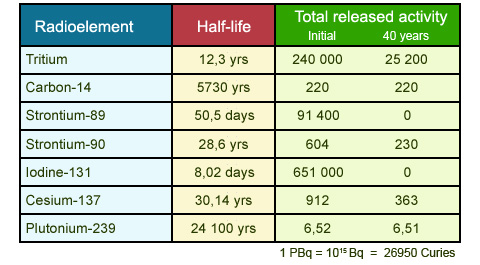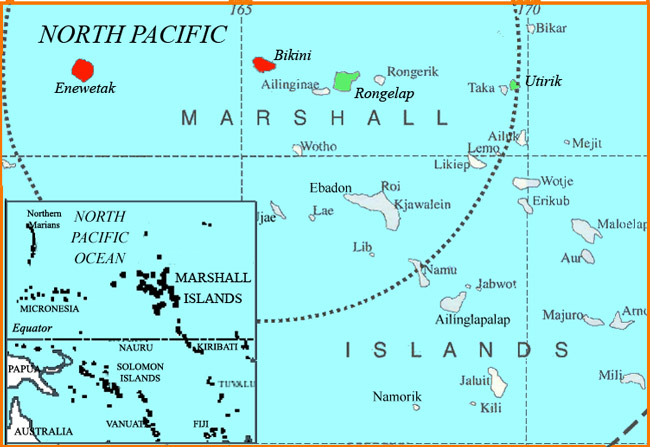An embarrassing legacy but alleviated with time
Radioactive fallout differ significantly according to the type of bomb. Fission reactions in A-bombs produce the full range of radioactive fission products and actinides. Fusion reactions – involved in H-bombs – will create tritium and generate a significant flux of neutrons that activate surrounding environments. For instance one of the most important activation products is carbon-14 formed from nitrogen in the air.

Cumulated released activities of nuclear tests
Estimates of the total amount of radioactive activity released during the nuclear tests of the 1950-60’s with the contribution of major radioactive nuclei. The activity of radioelements having a very short lifespan (Strontium-89, Iodine-131, etc …) which predominated by far when the tests were carried out has vanished 40 years after. Tritium activity is now by far the dominant contributor despite divided by 10.
© Source : UNSCEAR 1993
A few weeks after the tests, populations living near the explosion sites were exposed to the harmful effects of iodine-131, a source of thyroid cancer. This isotope has since long disappeared. Today residual exposures are mainly due to external irradiation from ground deposits and internal radiation through ingestion.
The average individual effective dose was estimated at 4.4 mSv (millisievert) in the northern hemisphere, 3.1 mSv in the southern hemisphere and globally to 3.7 mSv for the world population. This is a “committed” dose, calculated over a full lifetime.
The three main contributors to the committed effective dose received by the world population are carbon-14 (70%), cesium-137 (13%) and strontium-90 (3%). Ingestion contributes to 80% of the total dose. It should be noted that exposure to carbon-14 will be spread over a very long period of time : 5% on the first 100 years following the releases and 71% over the next 10 000 years.
People living near the sites where the tests were conducted were exposed to localized radioactive fallout and received higher doses than the average doses quoted above.

Cesium-137 fallout before Chernobyl
The map shows the distribution in Europe of Cesium-137 deposits (just before the 1986 Chernobyl accident) due to fallout from atmospheric nuclear tests of the 1950s and 1960s. Cesium-137, and to a lesser degree strontium-90, was the main contamination remaining on the ground. The cesium radioactivity is halved every 30 years but fortunately the fraction of this radioactivity which affects humans decreases much faster.
© Chernobyl Atlas
On US sites in the Nevada desert, nearly 100 surface tests were conducted between 1951 and 1962. A n estimated population of 180,000 people were living near the site. Individual thyroid doses up to one gray were received by children. During the other tests carried out by the United States on Bikini atolls in the Pacific, inhabitants of the nearby Rongelap and Utirik atolls were accidentally exposed. In some cases thyroid doses, due to the short-lived very radioactive iodine and tellurium-132 isotopes, have reached several tens grays.
have reached several tens grays.
Atmospheric tests were conducted between 1949 and 1962 on the Semepalatinsk site in the former Soviet Union, and underground tests between 1964 and 1989. About 10 000 people living on the edge of the site were exposed.

Bikini and Enewetak american tests sites
In the 1940 and 50’s the americans have carried out many nuclear tests on Marshall Islands atolls in the Pacific ocean, mainly on the Bikini and ‘Enewetak atolls shown in red on the map. The radius of the circle around the Bikini Atoll circle is 500 km. The 167 Bikini residents were evacuated by March 1946 and installed on other atolls. According to the 1996 IAEA report, the repopulation of Bikini was not recommended without remedial measures : the island could be occupied only on condition of not consuming local foods or water.
© ONU
Atomic tests were carried out by the United Kingdom in Australia, on the islands of Monte Bello and in the central desert at Maralinga and Emu. Small scale experiments were also conducted at Maralinga, causing the dispersion of 24 kg of plutonium-239 over an area of several hundred km2. If these desert areas were to be occupied some day, the committed doses resulting for future residents would range between a few mSv (millisieverts) to several hundred mSv.
Other articles on the subject « Military Applications »
Nuclear Weapons
Atomic and thermonuclear bombs There are two types of nuclear bombs: the atomic A bombs and the t[...]
The 1945 A-bombs
Little Boy and Fatman The United States had available three bombs in July 1945: two made of pluto[...]
The Franck Report
The Scientists who opposed dropping atomic bombs on Japan In June 1945, shortly before the atomic[...]
Nagasaki
A Japanese account of the Nagasaki bomb Atomic bomb, rescue and relief report, a poignant small b[...]
Nagasaki First Aid
Extracts from Doctor Takashi Nagai first report In this first rescue report intended for the auth[...]
Atoms for Peace
1953: Eisenhower’s initiative for peaceful use of the atom After the Second World War, The [...]
Testing Nuclear Weapons
A practice that culminates in the 1950’s and 1960’s… The nuclear tests conducted by the sup[...]
Arsenals reduction
A modest step towards a reduction in nuclear arsenals During the Cold War, the United States and [...]